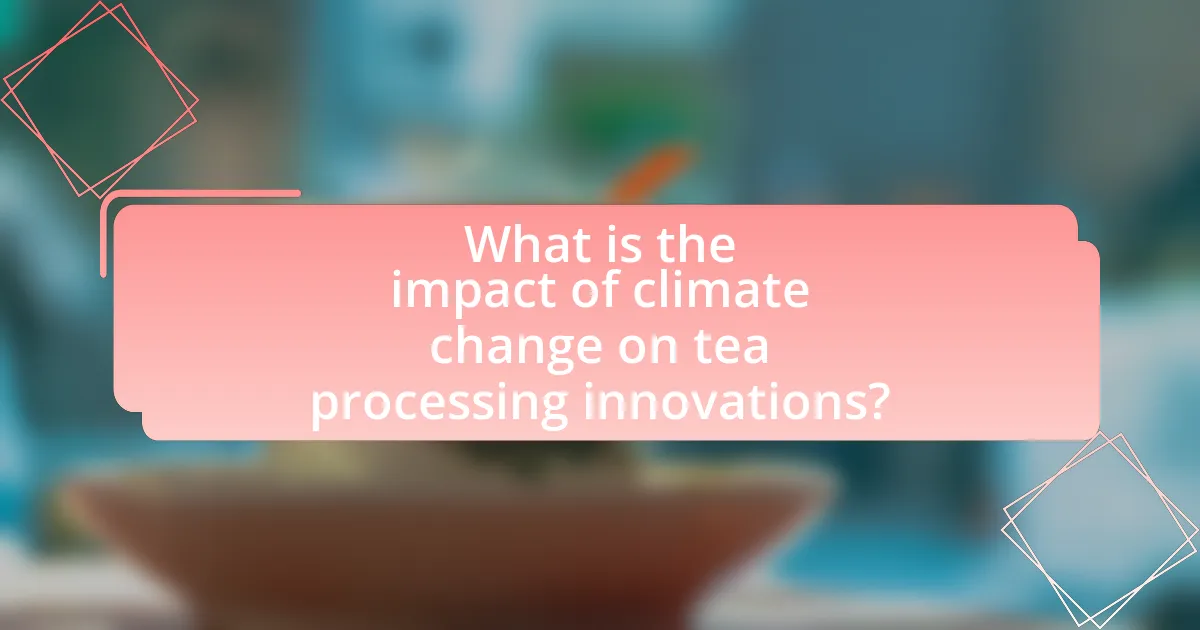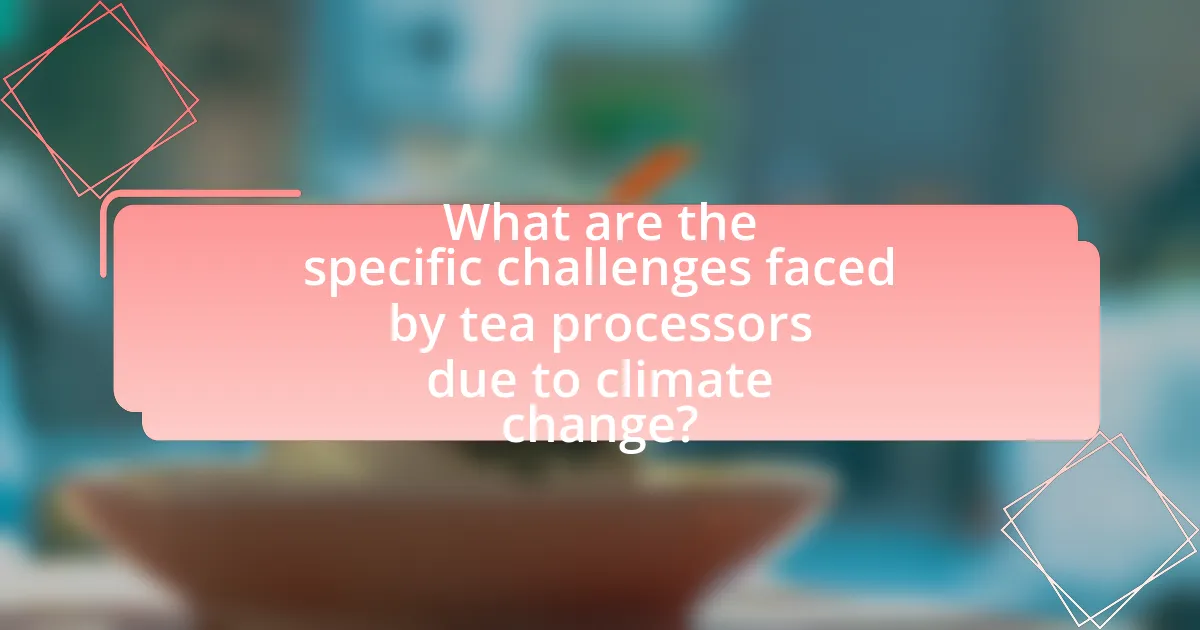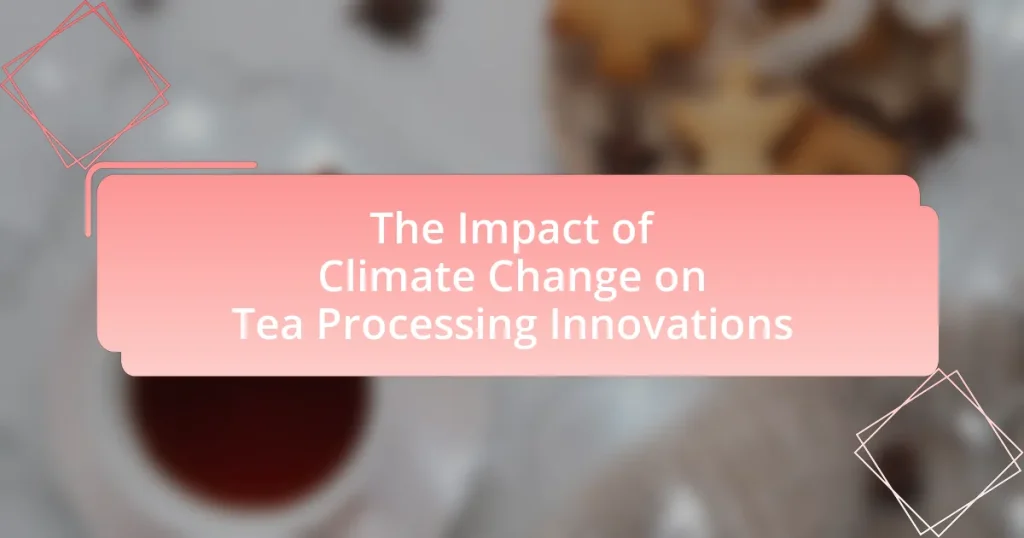The article examines the impact of climate change on tea processing innovations, highlighting the necessity for adaptations in processing methods and technologies to maintain tea quality and yield. It discusses how climate variability affects tea production through altered temperature and precipitation patterns, leading to innovations such as controlled fermentation, energy-efficient machinery, and sustainable practices. The article also explores specific climate factors influencing processing methods, the economic implications of failing to innovate, and the role of consumers in driving sustainable practices. Additionally, it outlines future trends in tea processing, emphasizing the importance of automation and data analytics in enhancing efficiency and sustainability within the industry.

What is the impact of climate change on tea processing innovations?
Climate change significantly impacts tea processing innovations by necessitating adaptations in methods and technologies to maintain quality and yield. As climate variability affects tea plant growth, processors are innovating techniques such as controlled fermentation and improved drying methods to enhance flavor profiles and preserve essential oils. For instance, research indicates that rising temperatures can alter the chemical composition of tea leaves, prompting the development of new processing protocols to ensure consistency in product quality. Additionally, innovations like energy-efficient machinery and sustainable practices are being adopted to mitigate the environmental footprint of tea processing, aligning with global sustainability goals.
How does climate change affect tea production and processing?
Climate change significantly affects tea production and processing by altering temperature and precipitation patterns, which directly influence tea plant growth and quality. For instance, rising temperatures can lead to increased pest and disease pressure, negatively impacting yield and quality. Additionally, changes in rainfall patterns can cause water stress or flooding, both of which can hinder the growth of tea plants. Research indicates that a 1°C increase in temperature could reduce tea yields by up to 10% in some regions. Furthermore, climate change can affect the timing of tea harvesting, as shifts in seasonal patterns may lead to misalignment with optimal harvesting periods, ultimately affecting the processing of tea leaves and the flavor profile of the final product.
What specific climate factors influence tea processing methods?
Specific climate factors that influence tea processing methods include temperature, humidity, and rainfall patterns. Temperature affects the enzymatic activity during oxidation, with higher temperatures accelerating the process, while lower temperatures slow it down. Humidity levels impact the drying process; high humidity can lead to slower drying and potential mold growth, necessitating adjustments in processing techniques. Rainfall patterns influence the timing of harvests and the quality of the leaves, as excessive rain can dilute flavor compounds. These factors collectively dictate the methods used in processing tea, ensuring optimal flavor and quality.
How do changes in temperature and precipitation affect tea quality?
Changes in temperature and precipitation significantly affect tea quality by influencing the growth conditions of the tea plants. Higher temperatures can accelerate the growth rate of tea leaves, potentially leading to an increase in polyphenol content, which enhances flavor and aroma. However, excessive heat can also stress the plants, resulting in lower quality leaves. Similarly, variations in precipitation impact soil moisture levels; insufficient rainfall can lead to drought stress, reducing leaf size and quality, while excessive rainfall can cause waterlogging, promoting diseases that degrade tea quality. Research indicates that optimal temperature ranges for tea cultivation are between 20°C to 30°C, and deviations from this range can adversely affect the chemical composition of the leaves, ultimately impacting flavor and market value.
What innovations are emerging in tea processing due to climate change?
Innovations in tea processing due to climate change include the development of climate-resilient tea varieties, advanced irrigation techniques, and the use of renewable energy sources in processing facilities. Climate-resilient tea varieties are being bred to withstand higher temperatures and altered precipitation patterns, ensuring consistent quality and yield. Advanced irrigation techniques, such as drip irrigation and moisture sensors, optimize water usage, which is crucial in regions facing droughts. Additionally, renewable energy sources, like solar and wind, are increasingly utilized in processing to reduce carbon footprints and enhance sustainability. These innovations are essential for adapting to the challenges posed by climate change, as evidenced by research from the International Tea Research Institute, which highlights the need for sustainable practices in tea cultivation and processing to maintain productivity in changing climates.
What new technologies are being adopted in tea processing?
New technologies being adopted in tea processing include automated sorting systems, precision fermentation techniques, and advanced drying methods. Automated sorting systems utilize machine learning and computer vision to enhance the quality control process by accurately identifying and sorting tea leaves based on size and color, thereby improving efficiency and consistency. Precision fermentation techniques allow for the manipulation of microbial processes to develop unique flavors and aromas in tea, catering to consumer preferences. Advanced drying methods, such as infrared and microwave drying, reduce energy consumption and processing time while preserving the tea’s essential qualities. These innovations are crucial in adapting to the challenges posed by climate change, ensuring sustainable production and maintaining quality standards in tea processing.
How are traditional processing methods being adapted to climate challenges?
Traditional processing methods in tea production are being adapted to climate challenges by incorporating sustainable practices and innovative technologies. For instance, producers are shifting to energy-efficient drying techniques and utilizing renewable energy sources, such as solar power, to reduce carbon footprints. Additionally, some tea processors are implementing precision agriculture techniques, which optimize water usage and enhance crop resilience against climate variability. Research indicates that these adaptations not only mitigate environmental impacts but also improve the quality and yield of tea, ensuring economic viability in changing climatic conditions.
Why is it important to innovate tea processing in response to climate change?
Innovating tea processing in response to climate change is crucial to ensure the sustainability and quality of tea production. Climate change leads to altered weather patterns, affecting tea plant growth and the quality of the leaves. For instance, increased temperatures and irregular rainfall can result in lower yields and diminished flavor profiles. Adapting processing techniques, such as optimizing withering and fermentation processes, can help mitigate these effects by preserving the quality of tea despite environmental stresses. Research indicates that innovative practices can enhance resilience, allowing tea producers to maintain productivity and meet consumer demand even as climate conditions become more unpredictable.
What are the potential economic impacts of failing to innovate?
Failing to innovate can lead to significant economic impacts, including reduced competitiveness, loss of market share, and decreased profitability. For instance, industries that do not adopt new technologies or processes may find themselves unable to meet consumer demands or adapt to changing market conditions, resulting in stagnation. A study by the McKinsey Global Institute indicates that companies that invest in innovation can achieve up to 30% higher revenue growth compared to those that do not. Additionally, in sectors like tea processing, failure to innovate in response to climate change can lead to increased production costs and lower quality products, ultimately harming economic viability.
How does innovation in tea processing contribute to sustainability?
Innovation in tea processing contributes to sustainability by enhancing resource efficiency and reducing environmental impact. For instance, advancements such as energy-efficient drying techniques and water recycling systems minimize energy consumption and water usage, which are critical in regions facing water scarcity. Research indicates that implementing these innovations can reduce energy use by up to 30% and water consumption by 50%, thereby promoting sustainable practices in tea production. Additionally, innovations like organic pest management and integrated farming practices help maintain biodiversity and soil health, further supporting sustainable agriculture.
How are tea producers responding to climate change challenges?
Tea producers are adapting to climate change challenges by implementing sustainable agricultural practices and investing in climate-resilient tea varieties. These producers are adopting techniques such as agroforestry, which enhances biodiversity and soil health, and utilizing water conservation methods to mitigate the effects of drought. For instance, research indicates that tea producers in regions like Assam, India, are increasingly using drip irrigation systems to optimize water usage, thereby improving yield despite changing rainfall patterns. Additionally, producers are collaborating with agricultural scientists to develop and cultivate tea varieties that are more tolerant to temperature fluctuations and pests, ensuring consistent quality and production levels.
What role do consumers play in driving innovations in tea processing?
Consumers play a crucial role in driving innovations in tea processing by influencing demand for sustainable and high-quality products. Their preferences for organic, ethically sourced, and environmentally friendly tea have prompted producers to adopt advanced processing techniques that minimize environmental impact. For instance, a study by the International Tea Committee highlights that consumer awareness of climate change has led to increased interest in innovative practices such as carbon-neutral processing and water-efficient methods. This shift in consumer behavior not only encourages tea producers to innovate but also aligns with global sustainability goals, demonstrating the significant impact of consumer choices on the evolution of tea processing.

What are the specific challenges faced by tea processors due to climate change?
Tea processors face several specific challenges due to climate change, including altered rainfall patterns, increased temperatures, and the prevalence of pests and diseases. Altered rainfall patterns can lead to either drought or excessive rainfall, both of which negatively impact tea yield and quality. Increased temperatures can accelerate the growth of tea plants but may also stress them, leading to reduced flavor profiles. Additionally, the rise in temperature and humidity creates favorable conditions for pests and diseases, which can devastate crops. According to a study published in the journal “Agricultural Systems,” climate change could reduce tea production by up to 50% in some regions by 2050, highlighting the urgency for tea processors to adapt to these challenges.
How does climate variability affect the supply chain of tea?
Climate variability significantly disrupts the supply chain of tea by affecting crop yields, quality, and production timelines. Changes in temperature and precipitation patterns can lead to reduced tea leaf production, as evidenced by a study from the International Centre for Tropical Agriculture, which found that extreme weather events can decrease yields by up to 30%. Additionally, climate variability can alter the timing of harvests, leading to mismatches in supply and demand. For instance, droughts can delay harvests, while excessive rainfall can lead to crop diseases, further impacting the availability of quality tea. These disruptions create challenges for logistics and distribution, as suppliers struggle to meet market needs, ultimately affecting pricing and availability for consumers.
What disruptions can occur in tea sourcing and distribution?
Disruptions in tea sourcing and distribution can arise from climate change, which affects weather patterns, leading to unpredictable rainfall and temperature fluctuations. These changes can result in reduced tea yields, as evidenced by a study from the International Centre for Tropical Agriculture, which found that climate variability could decrease tea production by up to 50% in some regions by 2050. Additionally, extreme weather events such as floods and droughts can damage tea plantations, further complicating sourcing efforts. Supply chain disruptions may also occur due to transportation challenges caused by adverse weather conditions, impacting the timely distribution of tea products to markets.
How do climate-related risks impact tea pricing and market stability?
Climate-related risks significantly impact tea pricing and market stability by affecting crop yields and quality. For instance, extreme weather events such as droughts and floods can lead to reduced tea production, which in turn drives up prices due to lower supply. According to a study published in the journal “Agricultural Systems,” climate change could reduce tea yields by up to 50% in some regions by 2050, leading to increased volatility in market prices. Additionally, fluctuations in quality caused by inconsistent weather patterns can further destabilize the market, as consumers may be willing to pay less for lower-quality tea. This interplay between climate risks and market dynamics underscores the vulnerability of the tea industry to environmental changes.
What are the environmental impacts of traditional tea processing methods?
Traditional tea processing methods have significant environmental impacts, primarily through deforestation, water usage, and energy consumption. Deforestation occurs as land is cleared for tea plantations, leading to habitat loss and biodiversity decline; for instance, in regions like Assam, India, extensive tea cultivation has resulted in the loss of forest cover. Water usage is another critical concern, as traditional methods often require large quantities of water for irrigation and processing, which can deplete local water resources and affect surrounding ecosystems. Additionally, energy consumption during processing, particularly in drying and withering stages, contributes to greenhouse gas emissions, especially when fossil fuels are used. These factors collectively highlight the environmental challenges posed by traditional tea processing methods.
How does energy consumption in tea processing contribute to climate change?
Energy consumption in tea processing contributes to climate change primarily through the emission of greenhouse gases from fossil fuel use. The processing of tea, which includes withering, rolling, fermenting, and drying, often relies on energy-intensive methods that typically utilize coal, oil, or natural gas. For instance, a study by the Food and Agriculture Organization indicates that the tea industry is responsible for significant carbon emissions, with estimates suggesting that energy consumption in processing can account for up to 30% of the total emissions in tea production. This reliance on non-renewable energy sources not only increases the carbon footprint of tea processing but also exacerbates global warming, leading to adverse effects on climate patterns that further impact tea cultivation and processing innovations.
What waste management issues arise from conventional tea processing?
Conventional tea processing generates significant waste management issues, primarily due to the large volumes of organic waste produced, such as tea leaves, stems, and dust. These organic by-products can lead to environmental pollution if not properly managed, as they may decompose and release greenhouse gases like methane. Additionally, the use of chemicals during processing can result in hazardous waste, which poses risks to soil and water quality if not disposed of correctly. According to a study published in the Journal of Cleaner Production, improper disposal of tea processing waste can contribute to soil degradation and water contamination, highlighting the urgent need for effective waste management strategies in the tea industry.

What future trends can we expect in tea processing innovations?
Future trends in tea processing innovations will likely focus on sustainability, automation, and enhanced flavor extraction techniques. As climate change impacts tea cultivation, processors are expected to adopt eco-friendly practices, such as using renewable energy sources and reducing water consumption. Automation technologies, including AI and robotics, will streamline production processes, improving efficiency and consistency. Additionally, advancements in extraction methods, such as supercritical CO2 extraction, will enable the production of higher-quality teas with distinct flavors. These trends are driven by the need to adapt to environmental challenges and consumer preferences for sustainable and high-quality products.
How might advancements in technology shape the future of tea processing?
Advancements in technology will significantly shape the future of tea processing by enhancing efficiency, quality, and sustainability. Innovations such as automated harvesting systems and precision agriculture techniques will allow for more efficient cultivation and processing of tea leaves, reducing labor costs and increasing yield. For instance, the use of drones for monitoring crop health can lead to timely interventions, optimizing resource use and minimizing waste. Additionally, advancements in processing technologies, such as improved drying and fermentation methods, can enhance flavor profiles and preserve the nutritional content of tea. Research indicates that these technologies can reduce energy consumption by up to 30%, contributing to more sustainable practices in the industry. Overall, the integration of technology in tea processing is poised to address challenges posed by climate change while improving product quality and operational efficiency.
What role will automation play in sustainable tea processing?
Automation will significantly enhance sustainable tea processing by increasing efficiency and reducing waste. Automated systems can optimize energy use, minimize water consumption, and ensure precise control over processing conditions, which are critical for maintaining quality while adhering to sustainability standards. For instance, automated sorting and grading technologies can reduce the need for manual labor and decrease the risk of contamination, leading to higher quality tea with less environmental impact. Additionally, data-driven automation can facilitate better resource management, allowing producers to adapt to climate variability and optimize their operations for sustainability.
How can data analytics improve decision-making in tea processing?
Data analytics can significantly improve decision-making in tea processing by providing insights into production efficiency, quality control, and market trends. By analyzing data from various sources, such as weather patterns, soil conditions, and consumer preferences, tea processors can optimize cultivation practices and processing methods. For instance, a study by the International Tea Committee found that data-driven approaches can enhance yield predictions by up to 20%, allowing producers to make informed decisions about resource allocation and harvesting times. Additionally, real-time analytics can help identify quality issues early in the processing stage, reducing waste and ensuring that the final product meets market standards. This data-centric approach ultimately leads to more sustainable practices and better alignment with consumer demands, thereby improving overall profitability in the tea industry.
What best practices can tea processors adopt to mitigate climate change effects?
Tea processors can adopt sustainable agricultural practices, such as organic farming, agroforestry, and integrated pest management, to mitigate climate change effects. These practices enhance soil health, increase biodiversity, and reduce greenhouse gas emissions. For instance, organic farming avoids synthetic fertilizers and pesticides, which contribute to carbon emissions, while agroforestry integrates trees into tea plantations, improving carbon sequestration. Research indicates that these methods can lead to a 20-30% reduction in emissions compared to conventional practices. Additionally, implementing water conservation techniques, such as rainwater harvesting and drip irrigation, can help manage water resources more efficiently in the face of changing climate patterns.
How can tea processors implement sustainable practices effectively?
Tea processors can implement sustainable practices effectively by adopting organic farming methods, reducing water usage, and utilizing renewable energy sources. Organic farming minimizes chemical inputs, which enhances soil health and biodiversity, leading to more resilient tea crops. For instance, a study by the International Tea Committee found that organic tea farming can increase soil organic matter by up to 30%, improving water retention and reducing the need for irrigation. Additionally, implementing water-efficient technologies, such as drip irrigation, can decrease water consumption by 30-50%, as reported by the Food and Agriculture Organization. Finally, transitioning to renewable energy sources, like solar or wind power, can significantly lower carbon emissions associated with tea processing, contributing to a more sustainable production cycle.
What resources are available for tea processors seeking to innovate?
Tea processors seeking to innovate can access various resources, including research institutions, industry associations, and technology providers. Research institutions, such as the Tea Research Institute, offer studies on climate-resilient practices and innovative processing techniques. Industry associations, like the International Tea Committee, provide networking opportunities and access to best practices in tea processing. Additionally, technology providers offer advanced machinery and software solutions that enhance efficiency and product quality, enabling processors to adapt to climate change challenges effectively.


